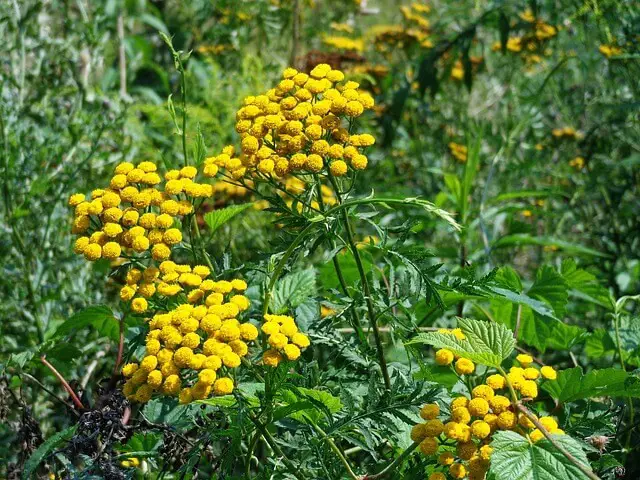14 Companion Planting Herbs To Repel Pests (From Anise To Wormwood)
When it comes to gardening, many people think of herbs simply as a way to add flavor to their dishes. However, these plants can do so much more than that. In fact, they have a profound impact on the neighboring plants when used as companion plants. By strategically placing certain herb species alongside other plants, gardeners can create a natural barrier against deer and insects. This approach, known as companion planting, offers a chemical-free way to control pests and diseases in the garden.
Whether you’re looking to reduce your reliance on pesticides or simply create a healthier flower bed, using herbs in this way is an effective choice. Not only do they repel unwanted visitors, but they also attract beneficial insects that can help spread pollen and attack unwanted pests.
More Companion Herbs Used as Repellents
#1. Anise

The annual herb’s distinctive licorice aroma and taste serve as a potent attractant for wasps. In a remarkable example of symbiotic relationships, these beneficial insects are drawn to the herb and subsequently prey upon aphids that infest nearby flora.
#2. Borage

When it comes to maintaining a healthy and thriving vegetable garden, many gardeners overlook one crucial element: Borage. This often underappreciated annual herb is more than just a pretty addition to your garden bed; it also serves as a natural deterrent for various pests that can wreak havoc on your tomato plants. Specifically, Borage has been shown to effectively repel tomato hornworms and cabbageworms, two common and destructive pests that can quickly devastate your tomato harvest.
#3. Catnip

This fragrant perennial is a feline favorite, but it’s not the go-to snack for ants, aphids, flea beetles, Japanese beetles, squash bugs, or weevils. When its duty as a natural guard is complete, catnip can be used to brew a soothing and flavorful tea that’s sure to bring calm to both humans and cats alike.
#4. Chervil

When seeking to minimize the presence of aphids and slugs in your garden, consider incorporating a natural deterrent into your crop rotation. One effective approach is to plant this particular specimen alongside lettuce and radishes, as it has been shown to repel these unwanted pests effectively.
#5. Comfrey

A notable characteristic of comfrey is its ability to absorb and store essential minerals such as calcium, phosphorus, and potassium. This unique property makes it a valuable ally for many fruit trees, including avocado, which thrive when comfrey’s nutrients are available to support their growth.
#6. Flax

While potato beetles may have a distaste for the perennial flax plant, surprisingly, inter-planting these two crops can have a profound impact on the health of your potato harvest. By combining their growth, you can expect to see improved yields and overall better plant quality.
#7. Hyssop

Hyssop, a versatile and fast-growing perennial herb, has been found to possess remarkable properties that make it an excellent natural deterrent for various pests. Its effectiveness in repelling unwanted visitors is particularly noteworthy when it comes to protecting cabbage and grape crops from damage.
#8. Mole Plant

The Castor Bean plant, also known as Ricinus communis, is a highly toxic species that serves as an effective deterrent against moles and mice when strategically placed throughout garden areas. In addition to its mole-repelling properties, this plant is the source of Castor Oil, a valuable commodity. When seeking natural methods for controlling pest populations, incorporating plants like the Castor Bean into your garden design can be a valuable strategy.
#9. Nasturtium

This dainty yet resilient plant, with its intricate appearance, not only adds visual appeal to your garden but also serves as a natural guardian against unwanted pests. Its presence can effectively deter the squash bug and whitefly, making it an excellent addition to any garden seeking protection.
#10. Pennyroyal

Pennyroyal, an often-overlooked herb, packs a punch when it comes to repelling various biting insects. Its leaves and tea can be used to deter fleas, chiggers, flies, and gnats from bothering you or your pets. For optimal results, crush the leaves and apply them directly to your skin. Alternatively, brew a Pennyroyal tea and use it to treat your pet’s coat.
#11. Rue

This hardy perennial herb boasts impressive pest-repelling capabilities, effectively warding off a diverse array of unwanted visitors. Its unique properties make it an excellent natural deterrent for aphids, flies, slugs, snails, flea beetles, and Japanese beetles, rendering them less likely to infest your garden or indoor spaces.
#12. Savory

The savory herb is a natural pest repellent that can help keep unwanted visitors like bean beetles, cabbage moths, and aphids at bay. But its benefits don’t stop there – beneficial insects such as honeybees also find the plant irresistible and will actually improve the growth of other plants when they’re present. This makes it an excellent addition to any garden looking to attract pollinators and create a more balanced ecosystem.
#13. Tansy

Tansy, a perennial herb characterized by its feathery appearance, may not be the most visually appealing addition to your garden, but it serves a crucial purpose. Its gangly stems can help deter aphids, ants, and other unwanted insects from infesting nearby plants. By repelling these pests, Tansy allows neighboring flora to thrive without the burden of insect damage, ensuring a healthier and more attractive garden overall.
#14. Wormwood/Silver Mound

Wormwood is often touted as a great border plant for keeping unwanted critters out of your garden, but its repellent properties don’t stop there. When made into a ‘tea’ to apply to other plants, wormwood can effectively deter cabbage moths, slugs, snails, black flea beetles, and even fleas. However, it’s essential to note that this plant is toxic, so be sure to use caution when applying the tea to your garden.
In fact, it’s recommended to avoid applying it directly to vegetable plants altogether.
Powders and Plant Teas
While the herbs listed here can be used to create powders for dusting or garden teas for soaking into soil or spraying on plants, it’s essential to consider the plant’s hardiness, potential contamination risks, and storage safety. Local Extension Agencies offer valuable guides on making plant teas, but it’s crucial to prioritize caution when using certain herbs that may be toxic. Proper labeling and secure storage are vital to prevent accidental exposure, especially around pets and children.
Despite these precautions, herbal teas and powders remain a natural, safe, and budget-friendly alternative to chemical insecticides.






